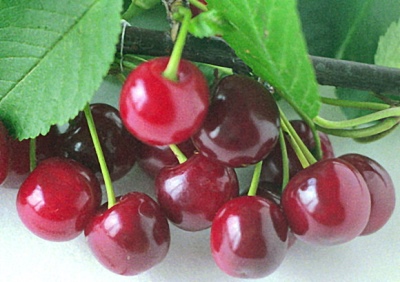
- Authors: E.P. Syubarova, P.M. Sulimova, M.I. Vyshinskaya, T.S. Shirko
- Barrel type: wood
- Growth type: vigorous
- Crown: medium density, pyramidal
- Flowering and fruiting type: mixed
- Fruit size: average
- Fruit shape: rounded
- Fruit color: dark red
- Fruit weight, g: 3,7
- Pulp color : Dark red
The Vianok cherry variety has been familiar to gardeners for a very long time. He gained fame thanks to the pleasant taste of the berries. In addition, Vianok cherry gives a decent harvest and is not capricious.
Breeding history
The variety was born at the Institute of Fruit Growing of the National Academy of Sciences of Belarus. It was the result of the works of breeders E.P. Syubarova, R.M.Sulimova, M.I.Vyshinskaya and T.S.Shirko.
Cherries were bred by free pollination of the then well-known Novodvorskaya variety.
He got on trials in Russia in 2004.
Description of the variety
Refers to the varieties of the felt type. The purpose is universal. The tree stands out for its tall growth (ranges from 2 to 3 meters). The crown resembles a pyramid in shape, is slightly raised and has an average density.
Fruit characteristics
In shape, the berries are similar to a circle, their size is small. The weight of the fruits ranges from 3.7 to 3.8 grams and they are shiny. Coloring of fruits in burgundy tones. The berries are easily detached from the stalk.
The pulp is dark red in color, it has medium density and is very juicy. The stone is obtained without effort, its size is moderate, equal to 3.1-5% of the weight of the fetus.
Taste qualities
Fans of this variety note its sour-sweet taste. Professionals give 4.5 points to the cherry during tasting.
Collecting a high yield of Vianok cherries, gardeners use berries in different ways: both fresh and processed.
The chemical composition of fruits includes: ascorbic acid (5.2 mg / 100 g), pectin (0.47%), titratable acids (1.1%), sugars (7.82%), mass fraction of dry substances (11.4 %).
Ripening and fruiting
The variety shows high early maturity. Cherries tend to harvest in the third year after planting. As for the ripening period, it is average, the trees begin to bear fruit in mid-July.

Yield
This variety is extremely productive, an average of 13 tons can be obtained per hectare, and the maximum yield is 22 tons of berries.
Self-fertility and the need for pollinators
The cherry in question is considered self-fertile. This suggests that the tree is pollinated with its own pollen, forming more than 20% of the ovaries. In addition, the cherry itself perfectly pollinates other varieties.
Landing
When planting Vianok cherries, a distance of 3 meters is left between young plants. When the seedlings are arranged in a row, the distance is increased to 5 meters.
It is better to dig holes in advance, in the fall, since the soil needs to settle and absorb fertilizers. On the eve of planting, the bottom must be drained. For this, rubble, tiles, broken bricks are often used.
Cherry trees are set in the middle of the hole, sprinkled with earth, but not completely - it is better to leave the root collar on the surface, about 5 centimeters. And also there is no need to hide the vaccination area underground, this prevents rotting.


Growing and care
They grow a tree in a place sheltered by an obstacle from the winds, for example, near a fence, but not in its shade.
The soil must be chosen light, sandy loam, loamy.
When caring for the crown of a tree, it is worth choosing a tiered form for it. To do this, you need to leave a short stem (within 40 cm) and form up to 12 skeletal branches in about 4 years. The distance between the branches can be 10-15 centimeters, and they should be directed in different directions.
It is necessary to regularly arrange pruning - sanitary and formative.
It is recommended to water Vianok cherries in moderation. During a drought, it is worth watering the tree during periods such as:
immediately after the formation of the ovary;
at the stage of fruit formation and budding.
When watering cherries, make sure that the water does not stagnate.
Top dressing is used to improve the quality of the crop. In the spring, the tree needs nitrogen. In the fall - phosphorus. In summer, potassium. In addition, in the summer, you can feed the plant with a solution of dung or manure. At least once within three years, compost or humus must be added to the soil.


Disease and pest resistance
The described cherry variety shows an average resistance to diseases and harmful insects, for example, with the threat of moniliosis and coccomycosis.
To fight diseases, you need to carry out preventive procedures on time.
In addition, it is advisable to carry out the treatment after picking the berries in order to resist the invasion of aphids. For spraying, a combination of insecticides with fungicides is well suited.
Requirements for soil and climatic conditions
Cherry variety Vianok heroically endures hot and dry weather, and also has a high degree of winter hardiness. Not picky about the quality of the soil.

Review overview
Reviews of this variety of cherries can be described as generally positive. Fans of the variety note that the berry is tasty, juicy enough, gives a considerable harvest and is not too capricious when grown.































































